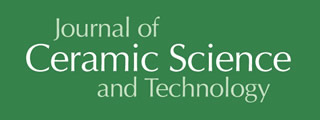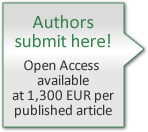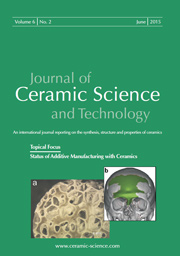Articles
All articles | Recent articles
Microscale-Motivated Continuum Damage Simulations of Brittle Ceramics under Thermomechanical Loading
J. Gundlach, D. Henneberg, J. Scheel, A. Ricoeur
University of Kassel, Institute of Mechanics, Chair of Engineering Mechanics/Continuum Mechanics, Mönchebergstraße 7, D-34119 Kassel, Germany
received February 1, 2016, received in revised form March 20, 2016, accepted May 2, 2016
Vol. 7, No. 2, Pages 145-154 DOI: 10.4416/JCST2016-00012
Abstract
Two approaches towards modeling damage in a brittle material caused by thermomechanical loading are presented. Both rely on microcrack growth, in the first case in a homogeneous matrix, in the second one at grain boundaries. Two-scale simulations e.g. of thermal shocks applied to single-phase or layered structures are performed in connection with the finite element method. Damage and crack patterns are predicted just as quantities like residual strength or critical temperature jumps.
![]() Download Full Article (PDF)
Download Full Article (PDF)
Keywords
Thermal shock, damage simulations, multiscale models, effective material properties
References
1 Lube, T., Baierl, R.G.: Sub-critical crack growth in alumina – a comparison of different measurement and evaluation methods, Berg- und Hüttenmännische Monatshefte, 156, 450 – 456, (2011).
2 Supancic, P.H., Schöpf, H.M.: Exact implementation of subcritical crack growth into a weibullian strength distribution under constant stress rate conditions, J.Eur.Ceram.Soc., 32, 4031 – 4040, (2012).
3 Henneberg, D., Ricoeur, A., Judt, P.: Multiscale modeling for the simulation of damage processes at refractory materials under thermal shock, Comput. Mater. Sci., 70, 187 – 195, (2013).
4 Henneberg, D., Ricoeur, A.: Numerical two-scale simulations of damage evolution at refractory materials, J. Ceram. Sci. Tech., 5, [2], 83 – 93, (2014).
5 Kolari, K.: Damage mechanics model for brittle failure of transversely isotropic solids. VTT Technical Research Centre of Finland, 2007.
6 Lemaitre, J., Desmorat, R.: Engineering damage mechanics. Springer-Verlag, Berlin Heidelberg, 2005.
7 Ricoeur, A., Kuna, M.: The thermoelectromechanical J-integral and the thermal permeability of cracks, Key Eng. Mater., 385 – 387, 569 – 572, (2008).
8 Gross, D., Seelig, T.: Fracture mechanics. Springer-Verlag, Berlin Heidelberg, 2011.
9 Nemat-Nasser, S., Hori, M.: Micromechanics: Overall properties of heterogeneous materials. 2nd edition. Elsevier, Amsterdam, 1999.
10 Kuna, M.: Numerical stress analysis of cracks, in German, Vieweg+Teubner, Wiesbaden, 2008.
11 Hill, R.: Elastic properties of reinforced solids: Some theoretical principles. J. Mech. Phys. Solids, 11, 357 – 372, (1963).
12 Kouznetsova, V.G., Geers, M.G.D., Brekelmans, W.A.M.: Advanced constitutive modeling of heterogeneous materials with gradient-enhanced computational homogenization scheme, Int. J. Numer. Meth. Engng., 54, 1235 – 1260, (2002).
13 Gitman, I.M.: Representative volumes and multi-scale modeling of quasi-brittle materials, Ph.D-Thesis, Delft University of Technology, Netherlands, 2006.
14 Miehe, C., Koch, A.: Computational micro-to-macro transitions of discretized microstructures undergoing small stress, Archive Appl. Mech., 72, 300 – 317, (2002).
15 Loehnert, S., Belytschko, T.: A multiscale projection method for macro/microcrack simulations, Int. J. Numer. Meth. Engng, 71, 1466 – 1482, (2007).
16 Oezdemir, I., Brekelmans, M.,G.,D., Geers, M.: FE2 computational homogenization for the thermo-mechanical analysis of heterogeneous solids, Comp. Methods Appl. Mech. Engrg., 198, 602 – 613, (2008).
17 Geers, M.G.D., Kouznetsova, V.G., Brekelmans, W.A.M.: Multi-scale computational homogenization: trends & challenges, J. Comp. Appl. Math., 234, [7], 2175 – 2182, (2010).
18 Wachtman, J.B., Cannon, W.R., Matthewson, M.J.: Mechanical properties of ceramics, 2nd edition. John Wiley & Sons, Inc., New York, 2009.
19 Barenblatt, B.: The formation of equilibrium cracks during brittle fracture, J. Appl. Math. and Mech., 23, 622 – 636, (1959).
20 Dugdale, D.S.: Yielding of steel sheets containing slits, J. Mech. Phys. Solids, 8, 100 – 104, (1960).
21 Needleman, A.: A continuum model for voids nucleation by inclusion debonding, J. Appl. Mech., 54, 525 – 531, (1987).
22 Hillerborg, A., Modeer, M., Petersson, P.E.: Analysis of crack formation and crack growth in concentrate by means of fracture mechanics and finite elements, Cement Concrete Res., 6, 773 – 782, (1976).
23 Rice, J.R.: A path independent integral and the approximate analysis of strain concentration by notches and cracks, J. Appl. Mech., 35, 379 – 386, (1968).
24 Griffith, A.A.: The phenomena of rupture and flow in solids, Phil. Trans. Roy. Soc., 163 – 197, (1920).
25 Judt, P. O., Ricoeur, A., Linek, G.: Crack path prediction in rolled aluminum plates with fracture toughness orthotropy and experimental validation, Eng. Fract. Mech., 138, 33 – 48, (2015).
26 Pilipenko, D., Natanzon, Y., Emmerich, H.: Multiscale modeling of thermoshock in aluminium oxide ceramics, Refractories Worldforum, 4, [1], 169 – 174, (2012).
27 Thomser, C., Skiera, E., Buerger, A., Linke, J., Loewenhoff, T., Schmidt, A., Singheiser, L., Steinbrech, R.: Thermal shock testing of refractory materials using an electron beam materials test facility, Int. J. Appl. Ceram. Tec., 9, [6], 1098 – 1103, (2012).
28 Hasselman, D. P. H.: Thermal stress resistance parameters for brittle refractory ceramics. J. Am. Ceram. Soc., 49, [12], 1033 – 1037, (1970).
29 Homeny, J., Bradt, R.C.: Thermal shock of refractories. In: Thermal stresses in severe environments. Plenum Press, New York, 1980.
Copyright
Göller Verlag GmbH


